Dupuytren’s Contracture
Dupuytren's Contracture occurs slowly over time, but can ultimately become a debilitating condition that prevents full hand function. In laymen's terms, this condition occurs when the tissue beneath the skin thickens and then hardens, eventually causing the fingers to be pulled toward the palm of the hand and preventing an individual from fully extending their fingers flat.
At Nebraska Hand & Shoulder, we have successfully helped patients with Dupuytren's Contracture restore to full mobility through surgical procedure. If you are suffering from Dupuytren's Contracture, contact our office today and schedule an appointment with our expert surgical staff.
Introduction To Dupuytren's Contracture
Dupuytren’s contracture is a problem that develops slowly in the palms and ultimately into the fingers and sometimes the thumbs of the hands of adults usually over the age of 40 or 50. It many times progresses slowly to pull the fingers towards the palm. It tends to begin in the ring ray, small finger ray, and ultimately may involve all of the digits in the worst afflicted. It tends to occur in slightly greater frequency in men and is autosomal dominant with incomplete penetrance which means that it may skip a generation or more only to show up in a family member without any expectation of same. What appears to be thickening of the skin and the development of a cord in the palm and into the finger or thumb is due to unusual growth in the fascial layer, i.e. the layer of tissue palmar to the tendons, nerves and blood vessels of the hand, but just below the skin. The same patient will rarely have involvement in the plantar aspect of the instep of the foot and even more rare a man may present with involvement of the penis resulting in a crooked penis- this is termed Peyronie’s disease.
Treatment
Initially Dupuytren’s may start as a tender nodule for which cortisone injection often yields some relief. Nothing actually halts the development or progression of the disease. It is not clear what triggers the development other than just the age of the given patient. Once it progresses to the point where a person can’t lay their hand flat, palm down flat on a tabletop, it is probably time to consider release of what is known as the pretendinous cord, the visible cord in the palm.
This can be done percutaneously with a needle or in some cases with use of collagenase in a select few. I don’t recommend collagenase because it is overly expensive and involves two visits for incomplete release without eliminating the underlying pathologic tissue. The absolute indication for Dupuytren’s surgery is when the person’s finger gets involved and starts pulling back at the middle joint.
Surgical intervention in the form of outpatient removal of the abnormal tissue is the most thorough and long-lasting treatment. Percutaneous release of any of the cord, i.e. Dupuytren’s aponeurotomy, heals the quickest and has the least side-effects and I believe it is better than collagenase when feasible, but again it doesn’t eliminate the tissue or progression. Only removal of the tissue with outpatient surgery will do that. The down time of a person’s hand after surgical removal has a lot to do with whether it is the dominant or non-dominant hand and the person’s occupation because a significant bandage must be placed on the hand for at least a week, sometimes two weeks, and there may be need for supervised exercises with a hand therapist or specialized bracing to help stretch the fingers back out. Part of this is determined by how severe the problem is at the time of surgical treatment.
Percutaneous Release

Before Percutaneous Release - Patient cannot lay hand flat

Before Percutaneous Release
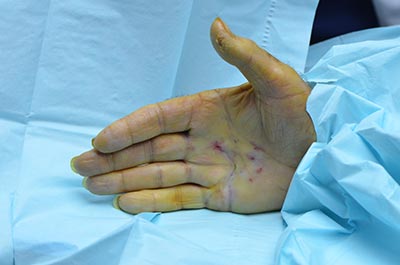
After Percutaneous Release - Full finger straightening
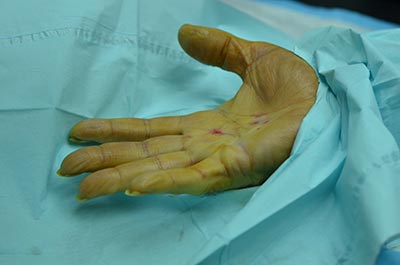
After Percutaneous Release
Open Surgical Procedure
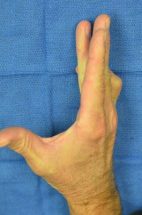
Before Open Surgical Treatment
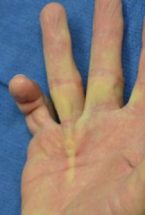
Before Open Surgical Treatment

Full Finger Straightening After Dupuytren's Excised
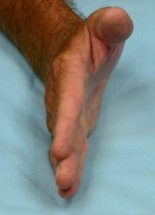
After Dupuytren's
WARNING MAY CONTAIN GRAPHIC IMAGES



